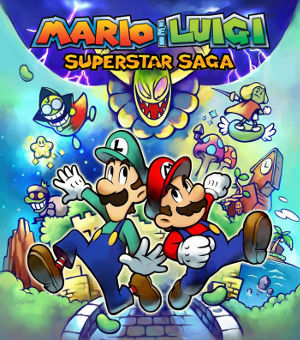
Mario & Luigi: Superstar Saga is a 2003 role-playing game developed by AlphaDream and published by Nintendo for the Game Boy Advance. It was re-released for the Wii U's Virtual Console in 2014, Nintendo Switch Online Service in 2023, and remade for the Nintendo 3DS as Mario & Luigi: Superstar Saga + Bowser's Minions in 2017. In the game, Mario and Luigi travel to the Beanbean Kingdom in order to combat Cackletta and Fawful, who stole Princess Peach's voice for the purpose of harnessing the power of a special artifact called the Beanstar.

Mario Party is a party video game series featuring characters from the Mario franchise in which up to four local players or computer-controlled characters compete in a board game interspersed with minigames. The games are currently developed by NDcube and published by Nintendo, being previously developed by Hudson Soft. The series is known for its party game elements, including the often unpredictable multiplayer modes that allow play with up to four, and sometimes eight, human players or CPUs.
Super Smash Bros. is a crossover platform fighting game series published by Nintendo. The series was created by Masahiro Sakurai, who has directed every game in the series. The series is known for its unique gameplay objective which differs from that of traditional fighters, in that the aim is to increase damage counters and knock opponents off the stage instead of depleting life bars.

Harvest Moon: Magical Melody is a social simulation video game for the GameCube developed by Marvelous Interactive. It is an updated version of Bokujō Monogatari: Shiawase no Uta, which was released on March 3, 2005 in Japan. The updated GameCube version was released in the United States by Natsume Inc. on March 28, 2006.

Blazing Angels: Squadrons of WWII is a flight combat video game for Microsoft Windows, Xbox, Xbox 360, PlayStation 3 and Wii. It was developed by Ubisoft Bucharest during the second fiscal quarter of 2006 for both the North American and European regions. The game features 46 different World War II fighter planes and allows the player or players to take part in several World War II events as a fictional squadron. Online support allows 16 players to take part in head-to-head and co-operative battles.
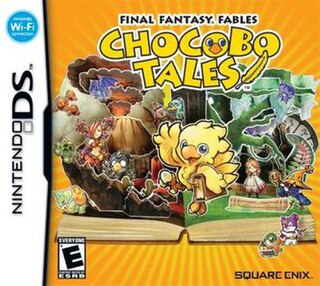
Final Fantasy Fables: Chocobo Tales, released in Japan as Chocobo to Mahō no Ehon is a Nintendo DS adventure game developed by h.a.n.d. and published by Square Enix. It was released in Japan on December 14, 2006, in North America on April 3, 2007, and in the PAL region in May.
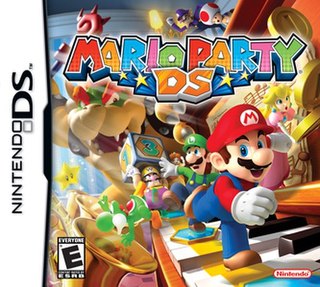
Mario Party DS is a 2007 party video game developed by Hudson Soft and published by Nintendo for the Nintendo DS. It is the second handheld game in the Mario Party series, as well as the last game in the series to be developed by Hudson Soft, as all subsequent titles have been developed by NDcube. The game was later released on the Virtual Console for the Wii U in April 2016.

Fossil Fighters, known as We Are Fossil Diggers in Japan, is a 2008 video game developed by Nintendo SPD, Red Entertainment, M2, and Artdink and published by Nintendo. It was first released in Japan on April 17, 2008, and was later released in North America on August 10, 2009, and in Australia on September 17, 2009.
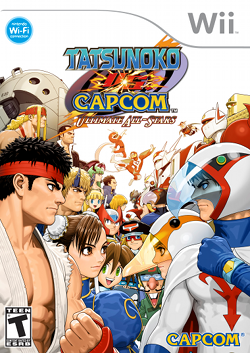
Tatsunoko vs. Capcom: Ultimate All-Stars is a crossover fighting game developed by Eighting and published by Capcom. The game features characters from both Capcom's video game franchises and various anime series produced by Tatsunoko Production. It was originally released in Japan for arcades and the Wii video game console in December 2008 as Tatsunoko vs. Capcom: Cross Generation of Heroes. Following high demand from international fans, Capcom worked with Tatsunoko to resolve international licensing issues and a second version, Ultimate All-Stars, was released for the Wii in North America, Japan, and Europe in January 2010, featuring additional characters and online multiplayer.

Dinosaur King is a video game for the Nintendo DS game based on the Dinosaur King TV series.

Glory of Heracles is a 2008 role-playing video game developed by Paon and published by Nintendo for the Nintendo DS. It is the sixth game of the Glory of Heracles series. It was originally released in Japan on May 22, 2008, and in North America on January 18, 2010, making it the first game in the series to be released outside Japan.

Might & Magic: Clash of Heroes is a puzzle role-playing video game developed by Capybara Games and published by Ubisoft for the Nintendo DS. Part of the Might and Magic series, it was first released on December 2009 in North America and February 2010 in Europe. In 2011, a downloadable high definition version was developed for the PlayStation 3, Xbox 360 and Microsoft Windows. Android and iOS ports developed by Tag Games were developed in 2013. A remake, titled Might & Magic: Clash of Heroes - Definitive Edition, developed and published by Dotemu, was released for the Nintendo Switch, PlayStation 4 and Windows in July 2023.
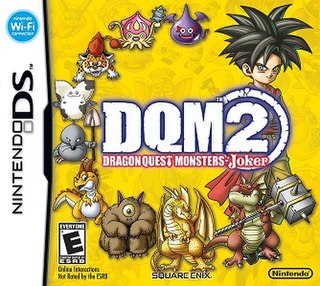
Dragon Quest Monsters: Joker 2 is a 2010 role-playing video game developed by Tose and published by Nintendo for the Nintendo DS. It is the sequel to Dragon Quest Monsters: Joker (2006) and is the fifth game in the Dragon Quest Monsters series. A sequel, Dragon Quest Monsters: Joker 3, was released in 2016.

Wii Party is a party video game developed by NDcube and published by Nintendo for the Wii video game console. The game heavily borrows game play elements from the Mario Party series, another Nintendo franchise. It is also the first game in the Wii series that Shigeru Miyamoto did not produce. The game was released in Japan on July 8, 2010, in North America on October 3, 2010, in Australia on October 7, 2010, and in Europe on October 8, 2010. Wii Party was revealed by Satoru Iwata in a Financial Results Briefing on May 7, 2010. It received mixed to positive reviews from critics and sold 9.35 million copies worldwide as of September 2021. A sequel, Wii Party U, was released for the Wii U on October 25, 2013.
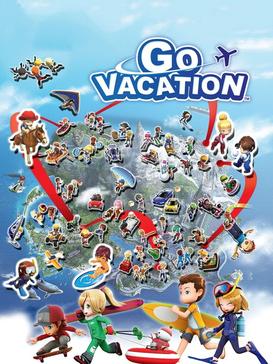
Go Vacation is a 2011 party video game developed and released by Bandai Namco Games for the Wii and Nintendo Switch. It is the third game in the We Ski series and a spin-off to the prior two main titles. Up to four players can compete against each other in over 50 sport-based minigames that take place in four fictional island resorts. Minigames range from activities such as kayaking and horseback riding, to activities like table hockey and minigolf. Different resorts can be accessed using vehicles such as trolleys and bicycles. Players can customize the outfit of their avatar and decorate their house with furniture.
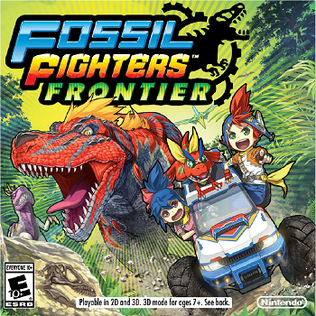
Fossil Fighters: Frontier is a 2014 video game developed by Spike Chunsoft, with assistance from Red Entertainment and Cyclone Zero, and published by Nintendo for the Nintendo 3DS console. The game is the third title in the Fossil Fighters series, and the first on the Nintendo 3DS. It was released in Japan on February 27, 2014, then in 2015 for North America on March 20 and on May 29 for Europe, making it the first installment of the series to be officially released in that part of the world.

Mario Party: Star Rush is a party video game developed by NDcube and published by Nintendo for the Nintendo 3DS. It is the fourth handheld game in the Mario Party series. The game features a new party mode known as Toad Scramble which deviates from the normal Mario Party series in its removal of turn-based gameplay in favor of the ability to move at will, simultaneous with other players, and without set paths on the game board.

Bravely Default II is a role-playing video game developed by Claytechworks and published by Square Enix. It was released worldwide for the Nintendo Switch on February 26, 2021, with Nintendo publishing the game on the platform outside of Japan, and was released for Windows on September 2, 2021. It is the third main installment in the Bravely series, following the original Bravely Default and its direct sequel Bravely Second: End Layer. It features a separate story, setting, and cast of characters.

Eiyuden Chronicle: Hundred Heroes is a 2024 role-playing video game developed by Rabbit and Bear Studios and published by 505 Games. It was led by Yoshitaka Murayama, creator of Konami's Suikoden series, and has been cited as a spiritual successor.

Weapon Shop de Omasse is a comedy rhythm JRPG written by Yoshiyuki Hirai, in which the main characters are a father and son pair who craft weapons for heroes in a fantasy weapon shop resembling the set of a sitcom. The player uses rhythmic gameplay to forge weapons which are rented by heroes for their quests; the weapon chosen will affect whether or not the hero is successful.


















